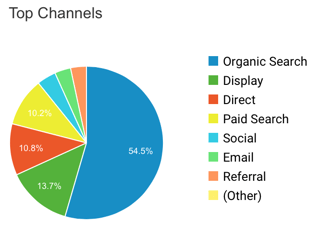11 Digital Marketing KPI’s You Should Be Tracking

When it comes to marketing, especially online, many people don’t know where to begin tracking their successes, or their failures. On one hand, you can go down a rabbit hole with the wealth of information available and get lost in the technicalities. On the other, you could not track anything and go strictly on gut instinct. Neither is beneficial if you really want to see where you’re thriving and where you’re falling short.
.png?width=763&height=382&name=13%20KPI's%20(2).png)
Every company and industry is different, and there are so many KPI’s that are beneficial to track. But the ones listed here are must haves in every marketing strategy. These will get you on your way to a successful marketing plan that is both measurable and attainable.
In no particular order:
1. Traffic by Channel
Keeping track of your website’s traffic is a no-brainer. This is a very high level metric to measure, but it can help you keep a pulse on your website’s health from a top level view. Don’t only look at overall traffic, but look into each traffic channel too.
Website traffic can consist of:
- Organic

- Direct
- Paid
- Referral
- Social
- Other
It’s beneficial to look into each channel and see how much traffic is coming from each. This can help guide you in your marketing strategy by focusing on channels that are already successful for you, and ones that need help. Say your social traffic is down 30% YOY, this can be a signal to you to spend more time on social media and maybe even direct some of your budget into paid ads on Facebook, Instagram, etc.
2. Website Conversion Rates
Do you know how many of your visitors actually convert to leads? You should! Conversion rates can tell you many things, including how qualified your site's traffic is. If you have a very low visitor to lead conversion rate, you need to start working on getting more qualified traffic. Every industry and company can vary greatly in their visitor to leads conversion rate, but on average it hovers around 1% to 5%.
Don't stop there. You want to not only measure and track general leads, but also break them down even further. Some common lead types to use are Marketing Qualified Leads (MQL) and Sales Qualified Lead (SQL). Marketing qualified leads can be anything you define them as. But I usually like to mark leads as MQL's when they engage with or download marketing materials such as eBooks, infographics, brochures, etc. SQL's can be any leads that fill out more bottom of the funnel forms, such as a contact us or book now type form. It is really up to you to decide what makes the most sense for your business.
3. Cost Per Acquisition (CPA)
This will show you how much your are spending to acquire a customer. Say you are spending $1,000 a month on marketing and you get 10 customers from your efforts, that would give you a CPA of $100 per customer. You would then have to determine if this is a good CPA for your business model. If your average order value (AOV) is $5,000, a CPA of $100 is great! If you're AOV is $20, you may need to figure out the best ways to lower your CPA to make it worth it. This is an extremely important metric to track regularly so you aren't spending way more than you are taking in.
4. ROI
.gif?width=250&height=140&name=giphy-downsized%20(17).gif) Which leads me to ROI. This is another important metric to keep track of to make sure your marketing dollars are being well spent. The formula is:
Which leads me to ROI. This is another important metric to keep track of to make sure your marketing dollars are being well spent. The formula is:
ROI = (gain from investment - cost of investment)/Cost of investment
This will give you a percentage that you can then use to see if your money is being allocated correctly. You can go as deep as you want to with this, and even break ROI down by traffic channel and see which source is giving you the biggest bang for your buck.
5. Cost Per Click (CPC)
Cost per click is important for all of your paid advertising online. This shows you how much you are paying each time a user clicks on one of your ads. This varies greatly by industry, but the lower the CPC, the better. If you have a low CPC, you are getting more clicks for your money. For example, if you are spending $500 a month on paid ads with an average CPC of $1.00 you can get 500 clicks. Whereas if your CPC was even slightly higher at $1.50, you would only be getting 333 clicks. Experimenting and participating in paid search is the only way to see what a normal and average CPC is for you. A lot of industries see CPC's somewhere in the $3 range, but industries such as the legal field can see CPC's as high as $20 or more.
6. Click Through Rates (CTR)
This is another metric that is important for your paid search advertising. The click through rate shows the percentage of people that click through your ads and go onto the landing page you have set up. This metric can show you how well your ad copy is written and how much you stand out from your competition. If you have a low CTR, you can work on your ad copy and ad set up to try and get the CTR up.
7. Inbound Link Building
The number of inbound links coming to your website is often overlooked. But this should be one you are keeping a close eye on. Inbound links are a huge SEO factor and a main thing Google looks at when determining your website's domain authority and ranking. There are many tools you can use to find your inbound links. You want high authority, trusted, and relevant domains linking to you. So if you see one that is not up to par, you can work on getting them to remove the link going to your site or disavow if all else fails.
8. Email Marketing Stats
.gif?width=196&height=250&name=giphy-downsized%20(18).gif) Email marketing is a main marketing strategy these days, and you better be keeping track of:
Email marketing is a main marketing strategy these days, and you better be keeping track of:
- Emails sent
- Emails Delivered
- Open Rate
- Click Rate
- Email subscribers lost
It's up to you how often you want to track these, but I recommend checking in on these metrics at least on a monthly basis. The open and click through rates can help you determine how successful your subject lines, content, and overall email aesthetics are performing.
9. Blog Metrics
Ah blogging, everyone's favorite. Blogging is a great way to increase your organic traffic and start ranking for a variety of keywords. This is one where I notice people have the most trouble in knowing what metrics to track to paint a picture of how well things are working. In order to get the best insights on your blog, I would track:
- Blog visits
- Blog visits by channel
- Top viewed posts
- Average Inbound links to a post
- Post engagement (like social shares, comments)
- Call to action (CTA) click through rate
These will help you determine what content is working. You can then recreate like blogs that will hopefully perform just as well, if not better.
10. Social Engagement
Social media is a great way to connect and interact with your audience. It is often only seen as a brand awareness tool. While this is true, it is now more than ever, a great place to capture leads and revenue. Posting and advertising on social is a must for any business in the 21st century. Keep track of these social media marketing KPI's and you will be sitting pretty:
- Engagement
- Reach
- Leads
- Conversions
11. Revenue from online sales
Now this is what it all comes down to. All of these other metrics are important to look at because it let's you keep a pulse on the health of your online marketing. But in the end, it all comes down to sales and revenue. How much is your website actually contributing to your bottom line? If your Google Analytics is set up and tracking correctly, this should be a very easy metric to measure.
In summation, measuring these KPI's and creating goals based on them, will keep you on track to a successful and thriving business!

January 9, 2018